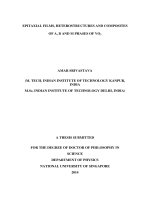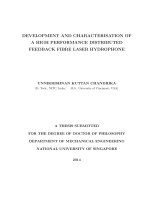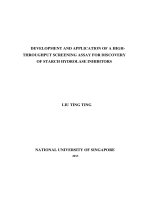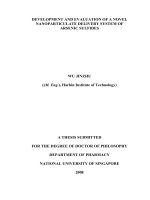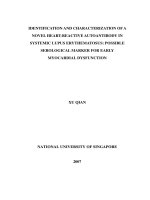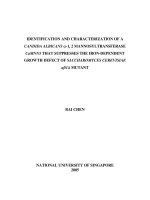Bioremediation and detoxification of a textile azo dye-evans blue by bacterial strain AKIP-2
Bạn đang xem bản rút gọn của tài liệu. Xem và tải ngay bản đầy đủ của tài liệu tại đây (287.58 KB, 8 trang )
Int.J.Curr.Microbiol.App.Sci (2017) 6(4): 2687-2694
International Journal of Current Microbiology and Applied Sciences
ISSN: 2319-7706 Volume 6 Number 4 (2017) pp. 2687-2694
Journal homepage:
Original Research Article
/>
Bioremediation and Detoxification of a Textile Azo Dye-Evans Blue by
Bacterial Strain AKIP-2
S. Aswin Kumar1, N. Arunagirinathan2, S. Vijayanand3, J. Hemapriya4 and V. Indra1*
1
Department of Zoology, 2Department of Microbiology, Presidency College,
Chennai, Tamilnadu, India
3
Department of Biotechnology, Thiruvalluvar University, Vellore, Tamilnadu, India
4
Department of Microbiology, DKM College, Vellore, Tamilnadu, India
*Corresponding author:
ABSTRACT
Keywords
E. coli strain
AKIP-2,
Evan’s Blue,
Textile effluents
Article Info
Accepted:
25 March 2017
Available Online:
10 April 2017
Increasing industrialization and urbanization result in the discharge of waste to the
environment, which in turn creates more pollution. Environmental biotechnology is
constantly expanding its efforts in the biological treatment of colored textile effluents,
which is an environmental friendly and low cost alternative to physico-chemical
decomposition processes. In the present study, effluent samples were collected from
various textile and dyeing industries located in and around Kanchipuram, Tamilnadu, India
and were exploited for the screening and isolation of bacterial strains that were capable of
decolorizing the textile dye, Evans Blue. Optimization of cultural conditions (Temperature,
pH, Agitation speeds and Dye concentrations) were carried out to maximize the bacterial
growth of E. coli strain AKIP-2 and its decolorization efficiency towards Evans Blue. Both
bacterial biomass and decolorization efficiency was found to be optimized at 35°C, neutral
pH, after 24 h of incubation. Static conditions proved to be effective in maximizing
decolorization. Increase in dye concentration decreased both bacterial growth and
decolorization efficiency of E. coli strain AKIP-2.
Introduction
Textile industry has a major impact not only
on the nation’s economy but also on the
environmental quality of life in many
communities.
Textile
manufacturing
consumes a considerable amount of water
approximately 100 litres of H2O kg-1 of textile
materials in its dyeing, finishing and
manufacturing processes (Tang and Chen,
1996). Considering both the volume
generated and the effluent composition, the
textile industry wastewater is rated as the
most polluting source among all industrial
sectors (Koyuncu, 2002). Strong color of the
textile wastewater is the most serious problem
of textile waste effluent. The disposal of these
wastes into receiving water causes damage to
the environment (Shyamala et al., 2014).
Dyes
may
significantly
affect
the
photosynthetic activity in aquatic life because
of reduced light penetration and may also be
toxic to some aquatic life due to the presence
of aromatics, metals, chlorides etc, (Husseiny,
2008; Hemapriya et al., 2010). In addition to
their visual effect and adverse impact in terms
of chemical oxygen demand (COD), many
synthetic dyes show their toxic, carcinogenic
2687
Int.J.Curr.Microbiol.App.Sci (2017) 6(4): 2687-2694
and genotoxic effects (Pearce et al., 2003).
Traditional wastewater treatment technologies
have proven to be markedly ineffective for
handling wastewater of synthetic textile dyes
because of the chemical stability of these
pollutants. Color is one of the most obvious
indicators of water pollution and the
discharge of highly colored synthetic dyes in
textile effluents can be damaging to the
receiving water bodies (Nigam et al., 1996;
Shyamala et al., 2014). Implementation of
physical/chemical methods have inherent
drawbacks of being economically unfeasible
(more energy consumption and chemical
uses), unable to remove the recalcitrant azo
dyes and/or their organic metabolites
completely, generating a significant amount
of sludge that may cause secondary pollution
problems (Zhang et al., 2004; Hemapriya and
Vijayanand,
2014).
The
microbial
decolorization and degradation of azo dyes
has been of considerable interest since it is
inexpensive, eco-friendly and produces a less
amount of sludge (Kalyani et al., 2008;
Saratale et al., 2009). The effectiveness of
microbial decolorization depends on the
adaptability and the activity of selected
microorganisms
including
bacteria,
actinomycetes, fungi, yeasts, and algae
capable of degrading azo dyes (Shyamala et
al., 2014).
Hence, the present investigation was intended
to assess the potential of AKIP-2 strain to
decolorize the synthetic textile azo dye, Evans
Blue under aerobic conditions, and to
optimize the culture conditions to maximize
the biomass and decolorization efficiency of
AKIP-2 Strain.
Materials and Methods
Sampling site and sample collection
The sampling area was the textile industries
and dyeing units located in and around
Kanchipuram, Tamil Nadu, India. The
effluent samples from both textile industries
and dyeing units were characterized by its
dark color and extreme turbidity.
Azo dye used
The commonly used textile azo dye, Evans
Blue used in this study was procured from a
local textile dyeing unit. Stock solution was
prepared by dissolving 1 g of Evans Blue in
100 ml distilled water. The dye solution was
sterilized by membrane filtration, since azo
dyes may be unstable to moist-heat
sterilization.
Isolation and screening of bacterial strains
decolorizing evans blue
Effluent samples were serially diluted and
spread over basal nutrient agar medium
containing 50 ppm of Evans Blue. Colonies
surrounded by halo (decolorized) zones were
picked and streaked on nutrient agar plates
containing Evans Blue. Different colonies of
dye decolorizing bacteria were picked and restreaked several times to obtain pure cultures.
Decolorization assay
A loopful of bacterial culture AKIP-2 was
inoculated in 100 ml of nutrient broth and
incubated at 150 rpm at 37°C for 24 h. Then,
1 ml of 24 h old culture was inoculated in 100
ml of nutrient broth containing 50 ppm of
Evans Blue and re-incubated at 37°C till
complete decolorization occurs. Suitable
control without any inoculum was also run
along with experimental flasks. 1.0 ml of
sample was withdrawn every 12 h and
centrifuged at 10,000 rpm for 15 min.
Decolorization extent was determined by
measuring the absorbance of the culture
supernatant at 590 nm using UV-visible
spectrophotometer
(Hitachi
U
2800),
according to Hemapriya et al., (2013).
2688
Int.J.Curr.Microbiol.App.Sci (2017) 6(4): 2687-2694
Decolorization efficiency (%) = Dye (i) - Dye
(r) / Dye (i) × 100
Where, Dye (i) refers to the initial dye
concentration and Dye (r) refers to the
residual dye concentration. Decolorization
experiments were performed in triplicates.
Bacterial strain and culture conditions
Bacterial strain that showed maximum
decolorization percentage on Evans Blue was
aerobically cultured in nutrient broth
containing 50 ppm of Evans Blue. The pH
was adjusted to 7.0. For frequent use, the
culture was maintained by transfer to a fresh
medium at 24 h intervals. When required for
prolonged periods, it was maintained by subculturing once every 7 days on slants,
prepared by solidifying the above mentioned
medium with 2.0 (w/v) agar.
Optimization of various culture conditions
for bacterial biomass and evans blue
decolorization by AKIP-2
Effect of temperature, pH, agitation rates
and dye concentrations
decolorizing ability of E.coli strain AKI-2.
Results of the present study revealed that the
dye decolorizing ability of the isolate was
dependent on the bacterial growth. The
bacterial cells started multiplying within 4 h
and reached their maximum growth within 24
h and thereafter started to decline, due to the
depletion of nutrients and accumulation of
toxic metabolites (Fig 1 and 2). In contrast,
decolorization of Methyl orange by Bacillus
sp. strain TVU-M4 was achieved after 32 h of
incubation (Shyamala et al., 2014).
Effect of temperature
The results shown in Fig 3 and 4 revealed that
E.coli strain AKI-2 showed strong
decolorizing activity and highest bacterial
growth from 30-40°C, with optimum being
35°C after 24 h of incubation. The incubation
at 30, 50 and 60°C was found to decrease
both bacterial biomass and dye decolorizing
ability of the bacterial strain; however the
decolorization percentage of the isolate was
found to be greatly inhibited at temperature
below 30°C. Decolorization of Congo Red by
Bacillus sp. VT-II was maximized at 40°C
(Sawhney and Kumar, 2011).
The effect of temperature, pH, agitation rates
and dye concentration on both bacterial
biomass and dye decolorizing ability of
AKIP-2 strain was studied. This was carried
out by incubating the bacterial strain at
different temperatures (20-60°C), different pH
values of the medium (pH 4.0-10.0), different
agitation speeds (0-200 rpm) and various dye
concentrations (200-1000 ppm). Bacterial
biomass and decolorization percentage was
measured at optimum growth (24 h).
Effect of pH
Results and Discussion
The pH tolerance of the decolorizing bacteria
is quite important because the reactive azo
dyes bind to cotton fibers by the addition or
substitution mechanisms under alkaline
conditions (Aksu et al., 2007).
Effect of incubation time
Incubation time played a significant role in
maximizing both bacterial growth and dye
E. coli strain AKI-2 grew well in a broad
range of pH (5.0-10.0) and its decolorizing
ability does not have strict pH requirement.
Bacterial biomass and dye decolorizing ability
was found to be optimized at neutral pH (7.0)
(Fig.5 and 6). Similarly, neutral pH was found
to be effective in maximizing both bacterial
growth and dye decolorization efficiency of
many bacterial strains.
2689
Int.J.Curr.Microbiol.App.Sci (2017) 6(4): 2687-2694
Fig.1 Effect of incubation time on bacterial biomass of E. coli strain AKI-2
Fig.2 Effect of incubation time on decolorization of evans blue by E. coli strain AKI-2
Fig.3 Effect of temperature on bacterial biomass of E. coli strain AKI-2
2690
Int.J.Curr.Microbiol.App.Sci (2017) 6(4): 2687-2694
Fig.4 Effect of incubation time on decolorization of evans blue by E. coli strain AKI-2
Fig.5 Effect of pH on bacterial biomass of E. coli strain AKI-2
Fig.6 Effect of pH on decolorization of evans blue by E. coli strain AKI-2
2691
Int.J.Curr.Microbiol.App.Sci (2017) 6(4): 2687-2694
Fig.7 Effect of agitation speed on bacterial biomass of E. coli strain AKI-2
Fig.8 Effect of agitation speed on decolorization of evans blue by E. coli strain AKI-2
Fig.9 Effect of dye concentration on bacterial biomass of E. coli strain AKI-2
2692
Int.J.Curr.Microbiol.App.Sci (2017) 6(4): 2687-2694
Fig.10 Effect of dye concentration on decolorization of evans blue by E. coli strain AKI-2
Effect of dye concentrations
References
The influence of different dye concentrations
(0-1000 ppm) were analyzed on bacterial
biomass and decolorization ability of E.coli
strain AKI-2. The results shown in Fig 7 and
8 revealed that the decolorization rate
increased linearly with increase in initial dye
concentration upto 100 ppm. As the dye
concentration increased in the culture
medium, a decline in color removal was
attained. At high concentration (1000 ppm),
Evans blue greatly suppressed both bacterial
biomass and decolorization ability.
Aksu,
Effect of agitation speeds
Microorganisms vary in their oxygen
requirement. The effect of various agitation
speeds (0-250 rpm) on the bacterial growth
and color removal capacity of E.coli strain
AKI-2 was studied at 35°C after 24 h of
incubation. The decolorization ability of the
isolate was found to be maximized at static
conditions. Shaking conditions highly
repressed the decolorizing ability of E.coli. In
contrast, the bacterial biomass was found to
be maximized when incubated at 200 rpm
(Fig 9 and 10).
Z., N.K.Kilic, S.Ertugrul and
G.Donmez. (2007). Inhibitory effects of
chromium (VI) and Remazol Black B
on chromium (VI) and dye stuff
removals by Trametes versicolor. Enz.
Microbiol. Technol., 40:1167-1174.
Hemapriya, J and S.Vijayanand. (2013).
Bioremediation of Structurally different
textile dyes by a novel bacterial
consortium.
Int.J.Curr.Microbiol.Appl.Sci.,
2(11):212- 226.
Hemapriya, J., Rajesh Kannan and
S.Vijayanand.
(2010).
Bacterial
decolorization of textile azo dye Direct
Red-28 under aerobic conditions. J.Pure
Appl.Microbiol., 4(1):309-314.
Husseiny, S.M. (2008). Biodegradation of
Reactive and Direct dyes using
Egyptian isolates. J. Appl. Sci. Res.,
4(6):599-606.
Kalyani, D.C., A.A.Telke, R.S.Dhanve and
J.P.Jadhav.
(2009).
Eco-friendly
biodegradation and detoxification of
Reactive Red-2 textile dye by newly
isolated Pseudomonas sp. SUK1. J.
Haz. Mat., 163:735-742.
Koyuncu, I. (2002). Reactive dye removal in
2693
Int.J.Curr.Microbiol.App.Sci (2017) 6(4): 2687-2694
dye/salt mixtures by nano filtration
membranes containing vinyl sulphone
dyes: Effect of feed concentration and
cross flow velocity. Desalination.,
143:243-253.
Nigam. P., I.M.Banat, D.Singh and
R.Marchant. (1996). Microbial process
for the decolorization of textile effluent
containing azo, diazo and reactive dyes.
Proc. Biochem., 31(5):435-442.
Pearce, C.I., J.R.Llyod and G.T.Guthrie.
(2003). The removal of color from
textile wastewater using whole bacterial
cells - A review. Dyes. Pigments.,
58:179-184.
Sawhney, R. and A.Kumar. (2011). Congo
Red (azo dye) decolorization by local
isolate VT-II inhabiting dye-effluent
exposed soil. Int. J. Environ. Sci.,
1(6):1261-1267.
Shyamala, A., J.Hemapriya, K. Vadakkan and
S.Vijayanand.
Bioremediation
of
Methyl Orange, a synthetic textile azo
dye by a halotolerant bacterial strain
Int.J.Curr.Research.Academic review.
2(8): 373-381.
Tang, W.Z. and R.A.Chen. (1996).
Decolorization kinetics and mechanisms
of commercial dyes by H2O2 / iron
powder system. Chemosphere., 32:947958.
Zhang, F., A.Yediler, X.Liang and A.Kettrup.
(2004). Effect of dye additives on the
ozonation process and oxidation byproducts: a comparative study using
hydrolyzed C1 Reactive Red-120. Dyes.
Pigments., 60:1-7.
How to cite this article:
Aswin Kumar, S., N. Arunagirinathan, S. Vijayanand, J. Hemapriya and Indra, V. 2017.
Bioremediation and Detoxification of a Textile Azo Dye-Evans Blue by Bacterial Strain AKIP2. Int.J.Curr.Microbiol.App.Sci. 6(5): 2687-2694.
doi: />
2694


